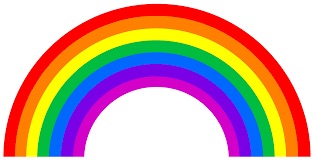
**WARNING: Never look directly at the Sun or other bright lights through diffraction gratings or with your unaided eyes. Looking at extremely bright lights can result in eye damage.**
Watch the video that accompanies this activity here.
Description:
Make your own rainbows with water and light! Then use a diffraction grating to explore rainbow spectra from light sources found around your environment (not the Sun). Tag us with your best rainbow pictures at #EAORainbowChallenge.
Background:
Hawaiʻi is sometimes called the Rainbow State because of all of the beautiful rainbows we get to see here. You don’t have to wait for the perfect conditions in Hawaiʻi to see rainbows – you can make your own rainbows anytime, anywhere!
Light is split into a rainbow of colors when it passes through a prism or a diffraction grating. In the case of rainbows, a raindrop acts like a tiny prism, reflecting light off of the side of the drop and back out to you as a beautiful rainbow.
Each element on the periodic table has its own unique fingerprint or wavelength. When light goes through the narrow slit of a diffraction grating, it spreads out the colors of light into a spectrum, making it possible to see which wavelengths make up the light that you see. Astronomers can use the light from far away stars and galaxies to determine which elements are present.
The unique fingerprints for specific elements don’t just appear in light we can see with our eyes (visible light) but across all different types of light. Using the James Clerk Maxwell Telescope (JCMT), we observe all kinds of things that our eyes cannot see! We often look at stellar nurseries – big gas clouds in space that are in the process of giving birth to stars. We also look at older stars and even entire galaxies to better understand their environment and to figure out how stars are born.
Pre-Activity Questions to Guide Inquiry:
- Do you ever look up at the night sky and wonder what space is made out of?
- What do rainbows have to do with telescopes and astronomy?
- How do you think astronomers figure out what space is made out of?
🌈 FOUR METHODS TO MAKE YOUR OWN RAINBOW! 🌈
- One way to make your own rainbow is to find an old CD you have at home. Use a flashlight or the Sun to shine onto the CD and it will reflect a rainbow onto your wall or wherever you shine it. If you lean it against a wall or a piece of furniture, you could even trace it to draw the rainbow too!
- Another way to create a rainbow is to get a glass of water and shine some light through it with the Sun or a flashlight. Can you find the rainbow?
- If it’s a sunny day outside, you can make rainbows with your garden hose. Just turn your back to the sun and spray the hose at about a 40-degree angle.
- Use a diffraction grating to study the different lights in your environment. Reminder: Do not look directly at the Sun. Do different lights produce different-looking rainbow spectrums? Some towns, like Hilo, Hawaiʻi, have sodium street lights that will have a spectrum worth checking out! Try taking a picture through your diffraction grating toward the different lights that you find.
Post-Activity Questions:
- How does the spectrum (rainbow) change with the different light sources you have examined?
- What do you think the diffraction grating does to light?
🌈 We hope you had fun exploring rainbows and light with us. Don’t forget to show us what rainbows YOU create and tag us at #EAORainbowChallenge! 🌈
Glossary:
Diffraction Grating: a plate of glass or metal ruled with very close parallel lines, producing a spectrum by diffraction and interference of light
Element: a pure substance that is made from a single type of atom. Elements are the building blocks for all the rest of the matter in the world. An element cannot be broken down into simpler substances by chemical means. e.g. Hydrogen, or Oxygen
Wavelength: the distance between 2 peaks of a wave. Bigger distances make redder light and smaller distances make bluer light.
Spectrum: a band of colors, as seen in a rainbow, produced by separation of the components of light by their different degrees of refraction according to wavelength



